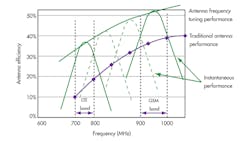Digital RF MEMS Capacitor Maximizes Smart-Phone Antenna Efficiency
This file type includes high resolution graphics and schematics.
Cavendish Kinetics now offers a tunable RF micro-electromechanical systems (MEMS) capacitor that lets smart-phone antennas cover a wider range of frequencies to ensure good efficiency.
Antennas can’t achieve maximum radiation efficiency unless they’re precisely tuned to the frequency of operation. However, most smart phones using LTE and other broadband modulation schemes operate in multiple bands that can extend from as low as 700 MHz to over 2300 MHz. Multiple antennas partially solve the problem, but they take up too much space in an already restricted package—and add cost as well.
The solution is to tune the antenna to the band in use. The simplest way to tune an antenna is to add a variable capacitor that can change the resonant frequency. Electronically variable capacitors have been available for years but have some disadvantages. For example, some digitally variable capacitors use MOSFET switches to add or subtract capacitors to or from a parallel connected network of capacitors. The on resistance lowers the Q of the overall capacitance and, therefore, the efficiency.
Cavendish solves this problem by using hundreds of tiny MEMS capacitors that are selected digitally in groups to vary the capacitance. The device behaves like a bank of 32 high-precision high-Q capacitors using a 1P32T switch with zero insertion loss. The capacitor has a 5-to-1 capacitance range from maximum to minimum, making wide-tuning frequency ranges possible. A serial peripheral interface (SPI) takes the digital code to vary the capacitance.
The figure illustrates the difference in performance between a standard un-tuned antenna and a Cavendish MEMS tuned antenna. Operating from 700 to 1000 MHz, the standard antenna efficiency is less than 40%. But tuning the antenna resonance at different parts of the range greatly improves the efficiency. This improved efficiency means more transmitted or received signal to ensure not only a reliable connection to the cell site but also higher data rates. In some cases, a smaller antenna can be used or an extra antenna can be eliminated.
In addition to antenna tuning, the Cavendish digitally variable capacitor can be used to design variable impedance matching circuits, power amplifier networks, variable filters, and phase shifters and other networks that must be optimized for the operating frequency. It is available in a 2- by 2- by 0.4-mm chip scale package (CSP). Its operating voltage is 1.8 V. Production samples are available now.
Cavendish Kinetics
This file type includes high resolution graphics and schematics.
About the Author

Lou Frenzel
Technical Contributing Editor
Lou Frenzel is a Contributing Technology Editor for Electronic Design Magazine where he writes articles and the blog Communique and other online material on the wireless, networking, and communications sectors. Lou interviews executives and engineers, attends conferences, and researches multiple areas. Lou has been writing in some capacity for ED since 2000.
Lou has 25+ years experience in the electronics industry as an engineer and manager. He has held VP level positions with Heathkit, McGraw Hill, and has 9 years of college teaching experience. Lou holds a bachelor’s degree from the University of Houston and a master’s degree from the University of Maryland. He is author of 28 books on computer and electronic subjects and lives in Bulverde, TX with his wife Joan. His website is www.loufrenzel.com.

